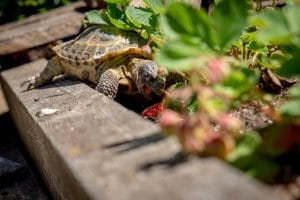Testudo marginata (Marginated Tortoise)
Home > Turtle Database > Testudo marginata (Marginated Tortoise)

The Marginated Tortoise (Testudo marginata) is the largest tortoise species native to Europe. Recognized by its flared rear shell, it thrives in rocky hillsides and scrublands. This hardy species is well adapted to dry climates and exhibits strong burrowing behavior.
Native To These Regions
Albania, Bulgaria, Corsica (France), Greece, Italy, North Macedonia, Sardinia (Italy), TurkeyNative Turtle Species Map – Find Turtles by Region
Scientific Classification
Kingdom: Animalia
Phylum: Chordata
Class: Reptilia
Order: Testudines
Family: Testudinidae
Genus: Testudo
Species: T. marginata
Common Names
Marginated Tortoise
This Hilarious Turtle Book Might Know Your Pet Better Than You Do
Let’s be real—most turtle care guides feel like reading a textbook written by a sleep-deprived zookeeper.
This one’s not that.
Told from the snarky point of view of a grumpy, judgmental turtle, 21 Turtle Truths You’ll Never Read in a Care Guide is packed with sarcasm, sass, and surprisingly useful insights.
And hey—you don’t have to commit to the whole thing just yet.
Grab 2 free truths from the ebook and get a taste of what your turtle really thinks about your setup, your food choices, and that weird plastic palm tree.
It’s funny, it’s honest, and if you’ve ever owned a turtle who glares at you like you’re the problem—you’ll feel seen.
Identification
Description
The Marginated Tortoise has a dark, elongated shell with distinct flared edges at the rear, giving it a unique appearance. The carapace is black or dark brown with yellowish highlights. The plastron is pale yellow with dark markings. Its limbs and head are grayish-brown, with rough, scaly skin. Adults can reach up to 35 cm (14 inches) in length and weigh around 5 kg (11 lbs).
Sexual Dimorphism
Males tend to have a more concave plastron, allowing for easier mating. They also have longer tails and more pronounced flaring at the rear of the shell compared to females, whose plastron is flatter.
Check more turtles from the Testudo genus
Native Origin and Distribution
Geographical Range
This species is native to Greece and parts of the Balkans, including Albania and Italy. It has also been introduced to other European regions through the pet trade.
Preferred Habitat
The Marginated Tortoise prefers rocky hillsides, Mediterranean scrublands, and open woodlands. It thrives in dry, arid climates with plenty of sunlight and seeks shelter in burrows or under vegetation to escape extreme heat.
Behavior
Feeding Habits
It is strictly herbivorous, feeding on grasses, wildflowers, leaves, and occasionally fruit. It has a slow metabolism and requires high-fiber, low-protein food to maintain good health.
Predators
Juvenile tortoises are preyed upon by birds, foxes, and rodents. Adults have fewer natural predators due to their thick shells, but they may still fall victim to large carnivores or human interference.
Reproduction
Breeding Season
Mating occurs in early spring and late summer, with males becoming territorial and engaging in head-bobbing displays to compete for mates.
Reproductive Method
Females lay 3-12 eggs per clutch in sandy or loose soil, typically in warm, sunlit areas. Incubation lasts around 90-120 days, with hatchlings emerging in late summer or early autumn.
Conservation
Extinction Status
The species is classified as Least Concern (LC) by the IUCN, but certain wild populations are declining due to habitat destruction and illegal collection.
Threats
Urbanization, agricultural expansion, and wildfires threaten its habitat. Additionally, poaching for the pet trade has reduced some local populations.
Conservation Measures
Strict protection laws exist in many parts of its range, and captive breeding programs help reduce pressure on wild populations. Conservationists also work to preserve Mediterranean scrublands and educate the public about responsible pet ownership.
Economic Importance
This species has significance in the pet trade, though strict regulations now control its export. It also plays a role in local ecosystems by grazing on vegetation and contributing to soil aeration through burrowing.
Interesting Facts
- The flared edges of its shell help deter predators and provide better stability when navigating rocky terrain.
- It can live over 100 years in captivity with proper care.
- Unlike many tortoise species, it can tolerate colder temperatures and may enter a state of hibernation during winter in northern regions.

About Author
Muntaseer Rahman started keeping pet turtles back in 2013. He also owns the largest Turtle & Tortoise Facebook community in Bangladesh. These days he is mostly active on Facebook.














